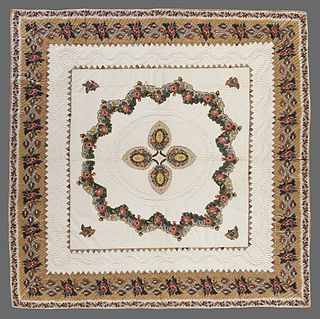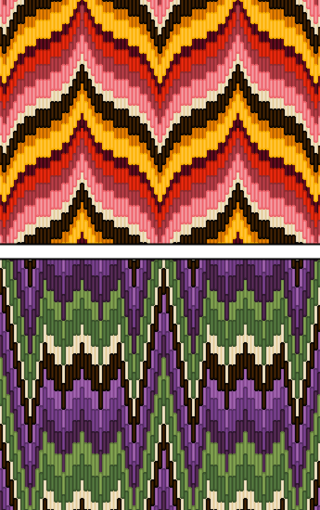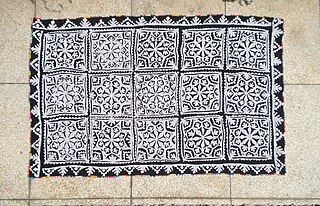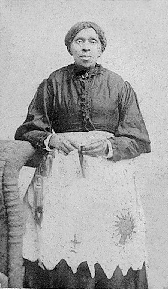Related Research Articles

Quilting is the process of joining a minimum of three layers of fabric together either through stitching manually using a needle and thread, or mechanically with a sewing machine or specialised longarm quilting system. An array of stitches is passed through all layers of the fabric to create a three-dimensional padded surface. The three layers are typically referred to as the top fabric or quilt top, batting or insulating material, and the backing.

Patchwork or "pieced work" is a form of needlework that involves sewing together pieces of fabric into a larger design. The larger design is usually based on repeating patterns built up with different fabric shapes. These shapes are carefully measured and cut, basic geometric shapes making them easy to piece together.

A quilt is a multi-layered textile, traditionally composed of two or more layers of fabric or fiber. Commonly three layers are used with a filler material. These layers traditionally include a woven cloth top, a layer of batting or wadding, and a woven back combined using the techniques of quilting. This is the process of sewing on the face of the fabric, and not just the edges, to combine the three layers together to reinforce the material. Stitching patterns can be a decorative element. A single piece of fabric can be used for the top of a quilt, but in many cases the top is created from smaller fabric pieces joined, or patchwork. The pattern and color of these pieces creates the design. Quilts may contain valuable historical information about their creators, "visualizing particular segments of history in tangible, textured ways".

Appliqué is ornamental needlework in which pieces or patches of fabric in different shapes and patterns are sewn or stuck onto a larger piece to form a picture or pattern. It is commonly used as decoration, especially on garments. The technique is accomplished either by hand stitching or machine. Appliqué is commonly practised with textiles, but the term may be applied to similar techniques used on different materials. In the context of ceramics, for example, an appliqué is a separate piece of clay added to the primary work, generally for the purpose of decoration.

Catonsville is a census-designated place (CDP) in Baltimore County, Maryland. The population was 44,701 at the 2020 US Census. The community is a streetcar suburb of Baltimore along the city's western border. The town is known for its proximity to the Patapsco River and Patapsco Valley State Park, making it a regional mountain biking hub. The town is also notable as a local hotbed of music, earning it the official nickname of "Music City, Maryland." Catonsville contains the majority of the University of Maryland, Baltimore County (UMBC), a major public research university with close to 14,000 students.

Broderie perse is a style of appliqué which uses printed motifs from one fabric to create a design on a background fabric. It was popular in the late 18th century and early 19th centuries. The technique could be considered an early form of puzzle piecing.

Bargello is a type of needlepoint embroidery consisting of upright flat stitches laid in a mathematical pattern to create motifs. The name originates from a series of chairs found in the Bargello palace in Florence, which have a "flame stitch" pattern.

Baltimore album quilts originated in Baltimore, Maryland, in the 1840s. They have become one of the most popular styles of quilts and are still made today. These quilts are made up of a number of squares called blocks. Each block has been appliquéd with a different design. The designs are often floral, but many other motifs are also used, such as eagles and landmarks. They have a background of white and incorporate many primary colors such as reds, greens and blues.

The history of quilting, the stitching together of layers of padding and fabric, may date back as far as 3400 BCE. For much of its history, quilting was primarily a practical technique to provide physical protection and insulation. However, decorative elements were often also present, and many quilts are now primarily art pieces.
Marie Daugherty Webster was a quilt designer, quilt producer, and businesswoman, as well as a lecturer and author of Quilts, Their Story, and How to Make Them (1915), the first American book about the history of quilting, reprinted many times since. She also ran the Practical Patchwork Company, a quilt pattern-making business from her home in Wabash, Indiana, for more than thirty years. Webster's appliquéd quilts influenced modern quilting designs of the early twentieth century. Her quilts have been featured in museums and gallery exhibition in the United States and Japan. The Indianapolis Museum of Art holds the largest collection of her quilts in the United States. Webster was inducted into the Quilters Hall of Fame in 1991. The Marie Webster House, her former residence in Marion, Indiana, was listed on the National Register of Historic Places in 1992, was designated a National Historic Landmark in 1993, and serves as the present-day home of the Quilters Hall of Fame.

Ralli,Rilli or Rillki quilts are traditional quilts of Sindh, in southeastern Pakistan, and the surrounding regions bordered by the Bahawalpur region of Punjab, Rajasthan and the Kutch region of Gujarat. Traditionally, they were made of cotton, but synthetic fabrics have increasingly been used since the late 1900s. The types, colors, and designs of ralli quilts vary depending upon the area in which they are made. There are different types of ralli making, three of which are widely known. These include appliqué, patchwork, and embroidered ralli. All rallis are handmade by women artisans of Sindh's remote areas. Embroidery designs and motifs indicate the nature, geometric and floral patterns from the area's ancient civilizations. Mothers used to explain several inheritance patterns to their daughters.

Harriet Powers was an American folk artist and quilter born into slavery in rural northeast Georgia. Powers used traditional appliqué techniques to make quilts that expressed local legends, Bible stories, and astronomical events. Powers married young and had a large family. After the American Civil War and emancipation, she and her husband became landowners by the 1880s, but lost their land due to financial problems.
Quilt art, sometimes known as art quilting, mixed media art quilts or fiber art quilts, is an art form that uses both modern and traditional quilting techniques to create art objects. Practitioners of quilt art create it based on their experiences, imagery, and ideas, rather than traditional patterns. Quilt art is typically hung or mounted.
Cuesta Benberry was an American historian and scholar. Considered to be one of the pioneers of research on quiltmaking in America, she was the pioneer of research on African-American quiltmaking. Her involvement in quilt research spans from founding and participating in various quilt groups to writing articles in renowned quilt magazines and journals. As a quilt scholar, Benberry acquired a collection of important quilts dating from the late 19th century up to the 21st century, as well as an extensive collection of paper documents supplementing quilting exhibitions, books, articles and her personal research.
Michael Francis James is an American artist, educator, author, and lecturer. He is best known as a leader of the art quilt movement that began in the 1970s. He currently lives and maintains a studio in Lincoln, Nebraska.

Gladys-Marie Fry was Professor Emerita of Folklore and English at the University of Maryland, College Park, Maryland, and a leading authority on African American textiles. Fry earned her bachelor's and master's degrees from Howard University and her Ph.D. from Indiana University. She is the author of Stitched From the Soul: Slave Quilting in the Ante-Bellum South and Night Riders in Black Folk History. A contributor or author to 8 museum catalogs, Fry is also the author of a number of articles and book chapters. Fry has also served as the curator for 11 museum exhibitions and consultant to exhibits and television programs around the nation.
Nancy Morrison Crow is an American art quilter and fiber artist. She is one of the leading figures in the development of the art quilting movement of the 1970s and 1980s, and is also known for her development of certain techniques to allow more spontaneity and expression.

Jean Ray Laury was an American artist and designer. She was one of the first fine artists to move to quilting as a medium of choice in the late 1950s. Her quilts followed neither traditional method nor pattern; they were bold, modern, colorful collages, often laced with humor and satire. Penning over twenty books and teaching over 2,000 workshops, Laury helped women see the creative possibilities in everyday objects and awake their sense of inspiration. Laury has been called a "foremother of a quilt revival", and "one of the pioneers" of non-traditional quilts.
Geraldine Elizabeth Kahle Beyer is an American quilt designer, quilter, author, teacher and lecturer. Considered by the quilting industry and the publishing media to be of the first designers to form a fabric collection suited to the needs of quilters, she began her career in India after she had run out of yarn. Beyer's works have won awards in the print media, and she has written about the history of quilting and her techniques. She has designed collections for fabric companies, and has taught and lectured on the subject domestically and internationally. Beyer was inducted into the Quilters Hall of Fame in 1984.

Gwen Marston née Gwendolyn Joy Miller was an American quilter, quilt teacher, lecturer, and author who championed a style of quilting she called liberated quiltmaking. She encouraged modern quilt makers to break away from using commercial quilt patterns and to learn to design their own unique pieces of art.
References
- ↑ Dalrymple, Amy (September 13, 2018). "2018 Alumni Awards: Mimi Dietrich '70, American studies". UMBC Magazine. Retrieved 2019-04-27.
- ↑ "Mimi Dietrich". Amazon.com. Retrieved November 17, 2014.
- ↑ "Mimi Dietrich's Books". Mimi Dietrich. Archived from the original on 2009-06-08. Retrieved 2008-11-29.
- ↑ "Mimi Dietrich". Martingale Company. Archived from the original on 2012-02-12. Retrieved 2008-11-29.
- ↑ "Teacher of the Year". International Association of Creative Arts Professionals. Retrieved November 17, 2014.
- ↑ "Catonsville woman's work quilting worthy of Hall of Fame". Baltimore Sun. Retrieved August 18, 2015.
- ↑ Dietrich, Mimi (June 25, 2015). "Quilting with Mimi Dietrich". Quilters Hall of Fame Blog (Interview). Interviewed by Alexander, Karen B. Retrieved 2019-04-27.
- ↑ "Hometown Girl: Contemporary Quilts of Mimi Dietrich". Greater Baltimore Cultural Alliance. 2019-04-23. Retrieved 2019-04-28.
- ↑ "Hometown Girl: Contemporary Quilts of Mimi Dietrich". Maryland Historical Society. Archived from the original on 2019-04-28. Retrieved 2019-04-28.
- ↑ Kast, Sheilah; Harvie, Maureen (March 22, 2009). ""Hometown Girl" Quilts!". www.wypr.org. Retrieved 2019-04-28.
- ↑ "Pink Ribbon Quilts". Amazon.com. Retrieved November 17, 2014.
